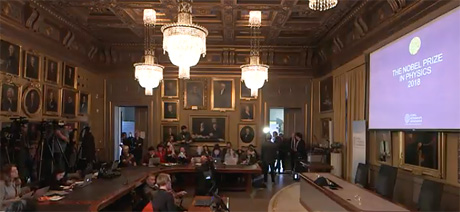- Home
- News and events
- Find news
- Nobel Prize in Physics awarded for revolutionising laser physics
Nobel Prize in Physics awarded for revolutionising laser physics
 The 2018 Nobel Prize in Physics is awarded for two inventions that have revolutionised the field of laser physics. The recipients consist of the scientist behind the so-called optical tweezers and the two researchers who came up with a method to generate high-intensity, ultra-short optic pulses.
The 2018 Nobel Prize in Physics is awarded for two inventions that have revolutionised the field of laser physics. The recipients consist of the scientist behind the so-called optical tweezers and the two researchers who came up with a method to generate high-intensity, ultra-short optic pulses.
‘The prizes are well deserved, and it’s great that one recipient is a woman,’ says Raimund Feifel, professor of physics at the University of Gothenburg.
The woman he is talking about is Donna Strickland from Canada, who is the third woman ever to be awarded the Nobel Prize in Physics. The last time a woman won the prize was 55 years ago. She shares the prize with Gérard Mourou from France for research that has paved the way for the shortest and most intense laser pulses ever created by humans.
Chirped pulse amplification
The technology is called CPA, chirped pulse amplification, and generates extremely sharp laser pulses with a very high effect for an incredibly short time. These laser pulses create a fantastic precision tool and make up the technology that has been used for example in connection with millions of corrective eye surgeries all over the world. The technology is also used in the manufacturing of stents used for example to expand coronary arteries. It has also become the standard technology used in high-intensity lasers at a large number of research laboratories.
Optical tweezers
The other half of the prize goes to Arthur Ashkin from the United States. Ashkin is the inventor of the optical tweezers, whose laser ‘fingers’ can grab particles, atoms, molecules and bacteria and other living cells with high precision. His invention is used in a wide range of areas.
‘It’s great news that Arthur Ashkin has finally received the Nobel Prize. His work laid the foundation for the 1997 Nobel Prize, which was awarded for the invention of laser cooling. Many members of the science community believe that he should have received the prize already back then,’ says Dag Hanstorp, professor at the University of Gothenburg.
The tweezers make it possible to manipulate single molecules and small cell parts. This creates new perspectives for both new medicines and basic research, which is the type of research that aims to expand the knowledge and theoretical understanding of something.
‘I think it’s great that the optical tweezers as a tool are acknowledged in this context. Even though the technology has already been used for decades, the applications will probably increase at a steady rate, as can be seen not least when looking at the number of times Arthur Ashkin’s original article has been cited,’ says Caroline Adiels, physics researcher at the University of Gothenburg.
Great benefit to humanity
Similar to the optical tweezers, the possible applications of CPA have not been fully explored either, indicating that the methods, just as Alfred Nobel would have wanted, will continue to benefit humankind for a long time.
Journalists may contact the following researchers at the University of Gothenburg for explanations and comments regarding this year’s Nobel Prize in Physics.
- Raimund Feifel, professor of physics, tel. +46 (0)70 838 16 89, email raimund.feifel@physics.gu.se
- Caroline Adiels, physics research, tel. +46 (0)76 168 00 24, email caroline.adiels@physics.gu.se
- Dag Hanstorp, professor of physics, tel. +46 (0)73 079 42 74, email dag.hanstorp@physics.gu.se
For more information about the 2018 Nobel Prize in Physics, see: https://www.kva.se/en/pressrum/pressmeddelanden/nobelpriset-i-fysik-2018